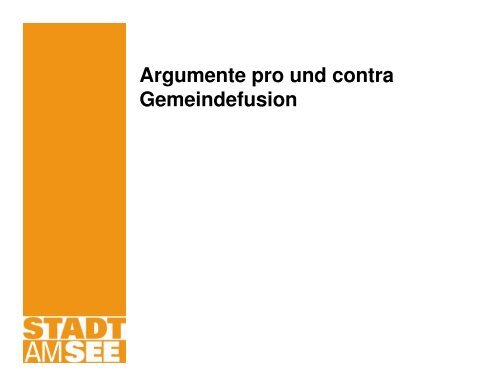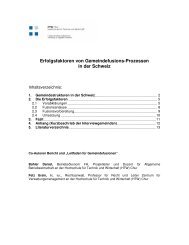Argumente pro und contra Gemeindefusion - Stadt am See
Argumente pro und contra Gemeindefusion - Stadt am See
Argumente pro und contra Gemeindefusion - Stadt am See
- No tags were found...
Create successful ePaper yourself
Turn your PDF publications into a flip-book with our unique Google optimized e-Paper software.
<strong>Argumente</strong> <strong>pro</strong> <strong>und</strong> <strong>contra</strong><strong>Gemeindefusion</strong>
LESSON 14-2: Reforming American Society, pgs. 456-461OBJECTIVE(S): For the student to be able to:1) identify reform movements that attempted to im<strong>pro</strong>ve society in America2) explain the efforts of labor movement to im<strong>pro</strong>ve working conditions3) identify specific areas of daily life that some reformers focused onim<strong>pro</strong>vingVOCABULARY, TERMS AND NAMES TO UNDERSTAND FOR THIS LESSON:Second Great Awakening(457)- renewal of religious faith in the 1790s and early 1800stemperance movement(458)- push toward the drinking of less alcoholShaker(458)- member of a Christian sect that practiced communal living and did not allow marriage or childbearinglabor union(459)- group of workers who band together to seek better working conditionsstrike(459)- to stop work to demand better working conditionsevangelicalism(*)- the doctrine/belief that each person can experience a sudden conversion and experience a newspiritual relationship with GodHorrace Mann(460)- reformer who advocated im<strong>pro</strong>ving educationDorthea Dix(461)- reformer who was a pioneer in the movement for better treatment of the mentally illComplete the following items.A Spiritual Revival1. Select one of the following statements that best describes the Second Great Awakening. [458]a. a movement driven by the idea that immigrants were arriving in too large of numbers; numbers should be limitedb. a religious movement that inspired people with the message that through Christianity, salvation was available toeveryone. (unlike the Puritan beliefs that only some people could be saved)2. TRUE / FALSE: Though not everyone followed the ideas of the Second Great Awakening, it did create an interestto reform society in other ways. [458]3. What did the temperance movement try to eliminate? [458] alcoholMaine and other states passed laws banning liquor but the laws were later repealedWorker's Rights4. What did factory workers do to try and im<strong>pro</strong>ve the poor conditions and unfair treatment in manufacturing jobs?[459] formed labor unions and went on strike to im<strong>pro</strong>ve conditions and pay5. TRUE / FALSE: The panic of 1837 made jobs more scarce and brought an end the labor movement. [459]Social Reform6. Who is credited with <strong>pro</strong>moting educational reform including emphasis on public education?[460] Horace Mann7. TRUE / FALSE: Though few schools during the 1800s accepted African Americans, Alexander Twilight (1823)and Mary Jane Patterson (1862) were the first male and female African Americans to earn college degrees. [460]8. List three other areas of society that reformers worked to im<strong>pro</strong>ve/change during the 1800s.a. treatment of mentally ill [461] b. disabilities (deaf/blind) c. prisons9
Demokratieargumente<strong>pro</strong>s• Politische Ämter werdenin kleinen Gemeindennicht optimal besetzt• GrössereAuswahlmöglichkeit• Grosse können besserauf Anliegen derBevölkerung eingehen• Professionellausgebildetes Personal,bessere Entscheide• Mehr Ressourcen stehenzur Verfügung, um aufAnliegen zu reagieren.cons• Bereitstellung „falscher“öffentlicher Güter (z.B.Prestigeobjekte)• Honoratiorenschichtherrschen, keine richtigenParteien mehr.• Abkoppelung der Wählervon der Politik• Distanz zwischenBürokratie <strong>und</strong> Bevölkerungnimmt zu
Verteilungsargumente<strong>pro</strong>s• Abhängigkeit vom Kantonnimmt ab• Gemeindeautonomiewächst• Mehr Gewicht inkantonalen Fragen• Kanton <strong>pro</strong>fitiert, dawenigerAusgleichsgemeinden,dadurch können Kantonemehr Mittel denGemeinden zuhalten• Dezentralisierung wirdgefördert• Ausgleich derSteueraufkommen, daReiche sich nicht mehr indie Agglo zurückziehenkönnencons• Entlastung der Kantone isteine Fiktion, da zweifinanzschwache Gemeindennachher immer nochschwach sind• Beratungsintensität durchden Kanton nimmt durch denZus<strong>am</strong>menschluss nicht ab,da die Quantität der Fragenzwar abnimmt, dieKomplexität jedoch zunimmt
Entwicklungsargumente<strong>pro</strong>s• Steigerung der Attraktivität(kulturell, wirtschaftlich)• Verbesserung derWettbewerbsposition(Bauland, <strong>pro</strong>fessionelleVerwaltung, single-point-ofcontact)• Fusion ist logischer Schritt,wenn bereits interkommunalzus<strong>am</strong>mengearbeitet wirdcons• Entwicklung kann zwargeplant werden, für dasEintreffen der Prognosengibt es keine Garantien




